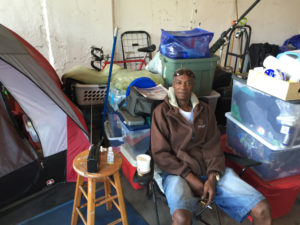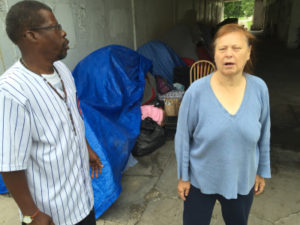
By Mark Brown, columnist
The Emanuel administration is expected to report soon that its annual head count shows the city’s homeless population is Chicago’s lowest in 10 years.
The 5,889 homeless persons found living in shelters, on the street or riding mass transit on the night of Jan. 26 is 13 percent fewer than counted in 2015.
But the tally will provide little solace to the Uptown residents who packed a hospital auditorium earlier this month to hear city officials report on their efforts to reduce the burgeoning tent encampments beneath North Lake Shore Drive viaducts.
Whether one’s sympathies lie with the complaining homeowners or with the homeless people, the news was not particularly encouraging.
Fewer than half of the 75 homeless individuals selected in April for a city pilot project that aimed to find them housing within 90 days are actually off the streets.
Of those, only 25 to date have found housing through the city’s efforts.
Another 11 are categorized as “inactive” because they left town, landed in jail, found a place on their own or just disappeared. Keeping track of homeless people can be like holding water in your hands.
Lisa Morrison Butler, the city’s family and support services commissioner, said November is the new target for getting housing for the other 39 people.
Even if that goal is met, there’s no reason to believe the Wilson, Lawrence and Foster viaducts will look much different to the public than they do now. More homeless people keep arriving to take the place of the original 75.
Many of those individuals came to the area as soon as they heard about the program, hoping to be the next to get housing. I predicted as much. Butler, though, said it caught her by surprise.
Although the rollout of the program has definitely been much slower than expected, I don’t see the delay as a sign of bad faith by anyone with the city. It’s more an indication of how daunting the problem is that the city decided to tackle without really having the resources to do it.
A shortage of suitable North Side housing for the tent-dwellers recently prompted the mayor to write a letter to landlords to seek their cooperation.
Butler never claimed the project was intended to solve homelessness, only to house the 75 and, in the process, to learn what it would take to help more.
I continue to find that refreshingly realistic. But it caused considerable grumbling at that community meeting, which was thick with the tension that comes when neighbors have passionate disagreements.
Uptown continues to be split between the “taxpaying homeowner” contingent, who want the “people under the bridge” to be removed one way or another, and the liberal types like me, who wish they had somewhere better to stay but aren’t bothered living around them.

On Friday, I visited with Donald King, 59, as he sat beside his tent on Lawrence. King — who was among the 75 chosen for help — said he’s been homeless since April 2015 after losing a warehouse job.
“They’re going slow, but it’s a process,” he said. “You’ve got to be patient.”
Still, King was frustrated he never got a chance at the community meeting to respond to audience members complaining about not being able to reach the lake for fear of the homeless people on the sidewalk.
“I would have told them: What you afraid of? We’re people just like you,” King said.
Over at Wilson Avenue, Roger Gardner and Denise Goad were more concerned they’ll still be in their tents when the weather turns cold.
“I don’t drink, I don’t smoke, and I don’t do drugs,” said Goad, 63, who grew up in Summit. “I just want somewhere to lay my head.”
Butler said her agency is encouraged by the reduced homeless count but won’t be celebrating “because there’s still so much to do.”
Amen.
